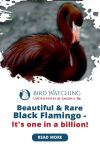
What’s This Post About?
Flamingos are tall bird species with long necks and sticklike legs. There are six different flamingo species, and all of them belong to the Phoenicopteridae family. Flamingos are primarily pink in color with thick bills and long wings. They are known to be one of the beautiful creatures on earth.
This post consists of information regarding the different colored flamingos rarely seen worldwide. The albino disorder will also be discussed and other reasons that might lead to discolorations in skin, eyes, or feathers. To know more about the rare kinds of flamingos, continue reading.
Flamingos have been recorded which have been affected by the albinic disorder, in which the bird may develop an unusual plumage. Flamingos of the color black and white have been spotted, but other color variations remain a myth.

What Are Flamingos?
Let’s talk about how a normal flamingo looks like.
| Physical Characteristic | Female | Male |
|---|---|---|
| Weight | 2.2 kg | 2.8 kg |
| Height | 120-145cm | 120-145cm |
| Wing Length | 370-408mm | 401-425mm |
These birds are known to symbolize balance, grace, and beauty. Flamingos are gregarious birds with four different species distributed throughout America, Asia, Africa, and Europe.

FUN FACT
Female flamingos are 20% smaller than male flamingos.
Identification
Flamingoes are tall, beautiful birds with long necks and webbed stick-thin feet. A flamingo usually has a pink-orangish overall plumage with dark shades on the head, rump, and neck. They have hints of black on their feathers.
The inner surface of a flamingo’s beak has a row of keratinous plates covered with tiny hair-like structures known as cilia.
To identify a flamingo, you can look at the following features:
- Pink-orangish beak with a black tip and a yellow shade near the eyes.
- Long, stick-thin, pink legs with darker knees.
- A thick, sharp bill turned downwards.
FUN FACT
Flamingos use their tongue as a piston to pump water. Their tongue fits into the groove that is found in the lower bill.
Plumage
Changes in flamingos occur as they transition through different life stages. However, the main difference that emerges is coloration. Flamingo babies, also called nestlings, are of grayish-white tones, and as these babies grow a little, they start showcasing specific changes.
Young flamingos develop a straight beak for the first two weeks. They have dark brown eyes and survive on crop milk for the first few months. When the young flamingo turns four weeks old, its plumage turns dark gray, including the legs.
The transition of young to subadult is interesting. At this stage, the dark gray plumage converts to a pale pink one. The wings have dark pink hues, and the subadult flamingoes start looking similar to an adult flamingo.
When the bird finally becomes an adult, they develop a bright pinkish-orange look. Eyes turn light yellow, and the wings start showing full deep colors. Their legs turn deeper pinkish-red, and the bill is fully developed with a downward bend.
FUN FACT
A flamingo’s lifespan is unknown; most flamingos have lived over 60 years.
Molting Period
Flamingos, like many other birds, also go through the process of molting. Molting occurs twice a year to once every two years. Common periods of molting are:
- Right before breeding: contour feathers wither off and are replaced with brightly colored feathers.
- Right after breeding: all feathers shed off and are replaced.
- Before laying eggs, the bird’s neck and head feathers might be replaced during the incubation period.
FUN FACT
Molting occurs gradually, which is why there is no flightlessness amongst flamingos.
Subspecies

There are different species within the flamingo family. The common characteristic in all species is that they all have black flight feathers, and the wings are of a darker pink shade than the rest of the body.
Subspecies of flamingos are:
- Lesser: Smaller flamingos with a pale pink body. They have a dark reddish-black bill and dark pink spotting on the back. The legs are a mixture of gray and pink. These species are mainly found in southeast Africa, western Africa, India, and the middle east.
- Greater: Have a very pale pink body, head, and neck. Their body is of a light pink tint, and the bill is also of a dull black shade. Primarily found in Africa, Southern Russia, the Mediterranean, and the Middle East.
- American: Brightest flamingo of all the species. They have dark pink legs and a dark black lower bill.
- Andean: A deep pink neck and head with pink spotting on the breasts. Bright yellow legs with a sharp, black-tipped bill. Overlaps with the Chilean and James’s species regions.
- James’s: Smaller than both the Andean and Chilean subspecies. They have dark pink spots on the breasts and a red circle lining the edges of the eyes. They are mostly found in high elevated areas.
- Chilean: Slightly smaller to Greater Flamingos in size. The breast and neck area becomes pinker during the breeding period. Legs are of a greyish-yellow shade with a pale pink bill, tipped with black. Found mostly in southwestern South America in Peru, Argentina, Bolivia, and Chile.
Are Flamingos Always Pink?
Exploring the phenomenon behind differently colored flamingos.
Flamingos are known to be pink-colored birds. They get their bright pink hues from different pigmentations known as canthaxanthin and astaxanthin. However, genetics or diet changes may lead to certain disorders which may cause discoloration in flamingos, making them appear of a different color.
FUN FACT
Flamingos eat with their heads upside down.
Pink Flamingos
The bright pink feathers, beak, and legs of a flamingo result from the pigment carotenoid. Carotenoids are metabolized into many byproducts and deposited through the bloodstream to different body parts. These different by-products are:
- Astaxanthin, which contributes to the skin color of legs and a minor pigment to the feathers.
- Canthaxanthin is the main pigment present in the feathers of all flamingo species, including the scarlet ibis and the roseate spoonbill.
The carotenoids need to be ingested into the flamingo’s body since there is no blood supply to a flamingo’s feathers once they are fully grown.
FUN FACT
The main predators of flamingos are raccoons, gray foxes, crocodiles, and jaguars.
Black Flamingos

A black flamingo is very rare to find. It was last spotted in 2015 at the Akrotiri Environmental Center on the Mediterranean Island. Another instance where this black flamingo was spotted was in Israel in 2013.
The flamingo turned black instead of pink due to a genetic condition known as melanism. Melanism creates excessive pigments sometimes that may darken the feathers of any bird. Melanism can occur due to a genetic mutation, but it can result from a specific diet in rare cases.
Melanism can benefit the bird by helping it trick the predators; however, too much pigment can also cause the feathers to turn dry, brittle, and weak.
Black feathers may also fail to attract other rosy prink flamingos for mating, leaving the black flamingo alone during the breeding seasons.
FUN FACT
Flamingos use pigment from their glands as makeup to attract mates.
Blue Flamingos

There is little to no information available about blue flamingos. Do blue flamingos exist? No, it is just a rumor. Pictures of pink flamingos are photoshopped to manipulate and confuse the audience, tricking them into believing blue flamingos exist.
Other heard rumors are:
- Flamingo eggs contain pink egg yolk.
- A flamingo can transition into different colors via consuming pigmented food.
In reality, both the statements above have been proven false.
Green Flamingos
Green flamingos do not exist in reality. There were many rumors about a green flamingo being spotted. However, the theory was proved wrong.
Most people believe that the tale of green and blue flamingos might be accurate because flamingos eat many blue-green algae, but this is not true. Even if flamingos are fed blue or green pigmented food, it is not theoretically possible for them to switch to these colors.
The birds tend to pick out carotenoid pigments from the blue-green algae, supporting the pink tint of flamingos.
FUN FACT
Flamingos cannot digest carotenoids; hence, it needs to be ingested.
Albino Flamingos

Albinism in flamingos results from a genetic mutation that interrupts the melanin production in the bird’s body. In this disorder, the flamingo tends to turn white with pinkish eyes.
Albino flamingos lack pigments on all body parts – skin, hair, eyes, feathers, etc. As a result, these flamingos are quick to develop health issues like blindness.
FUN FACT
A group of flamingos is called a flamboyance.
What Can Cause Discoloration in Flamingos Making Them Rare?
We know significant details about the albino disorder; however, many more conditions need to be discovered.
Birds may show weird color variations due to various factors; while some are adopted from genetics, others are from their diet. List of reasons why a bird may exhibit a lack of color on their skin are:
- Albinism.
- Partial Albinos: Leucism and Hypomelanism.
- Xanthochroism.
- Erythrism.
- Melanism.
Partial Albinos
Partial albinos mean that the flamingo has a paler pigmentation than the normal ones. This disorder may lead to the development of irregular white patches on the bird’s body.
The factors contributing to partial albinism are genetics, distortions in the development process, old age, and injury. The birds may show regular plumage on the wing bars or masks in partial albinism. The reasons for this disorder are:
- Leucism: Defect in pigment cells that cause the animal to look paler than usual. The eye color is not affected and stays the same.
- Age or injury may lead to the formation of white patches on the bird’s body. The feathers that may grow after an injury might lack pigment leading to partial albinism.
- Hypomelanism: A genetic mutation that disrupts melanin production, causing the bird to develop a whiter plumage.
Xanthochroism
This condition leads to the development of a yellowish-orange plumage instead of reddish-pink in the birds. This can be a cause of genetic variation or deficiencies in the diet.
House finches have been reported to exhibit Xanthochroism, where they portrayed a duller plumage than usual.
Erythrism
In this disorder, some flamingos may seem redder than normal. This is also developed by genetic modification or changes in diets.
Abnormal redness is observed on the animal’s feathers, skin, or fur under this condition.
DID YOU KNOW?
Ruffed Grouse and Screech-Owl are two species that were reported with erythrism.
Keep Reading!
Bird species like flamingos are primarily pink. If a different color is reported in certain species that is not their actual color, there might be various reasons—conditions such as albinism, xanthochroism, and more. Many conditions may cause discoloration in the plumage of a flamingo or any other bird, making it appear different than usual.
Certain rumors have been spread about ‘rare flamingos’, including green and blue, which are not true. To ensure that a fact about a particular animal is actual or not, you should always seek proof. For example, the existence of green flamingos, which many individuals believed – in reality, is false.
Albinism is a severe disorder with many side effects. Unfortunately, as stated above, flamingos are not the only animal species that have fallen prey to this genetic disease. If you are interested to learn more about albinic animals, read our post on albino cardinals and their unique features.
The Rare Albino Cardinal! 4 Amazing Images And 12 FAQs
Just spotted a Cardinal with snowy white plumage in your yard? You're lucky to sight one of the rarest species! Learn all about Albino Cardinals here.

By David A. Swanson
Bird Watching USA
My name is David and I'm the the founder of Bird Watching USA! I started Bird Watching with My father-in-law many years ago, and I've become an addict to watching these beautiful creatures. I've learnt so much over about bird watching over the years that I want to share with the world everything I know about them!

David A. Swanson
Bird Watching USA
My name is David and I'm the the founder of Bird Watching USA! I started Bird Watching with My father-in-law many years ago, and I've become an addict to watching these beautiful creatures. I've learnt so much over about bird watching over the years that I want to share with the world everything I know about them!









